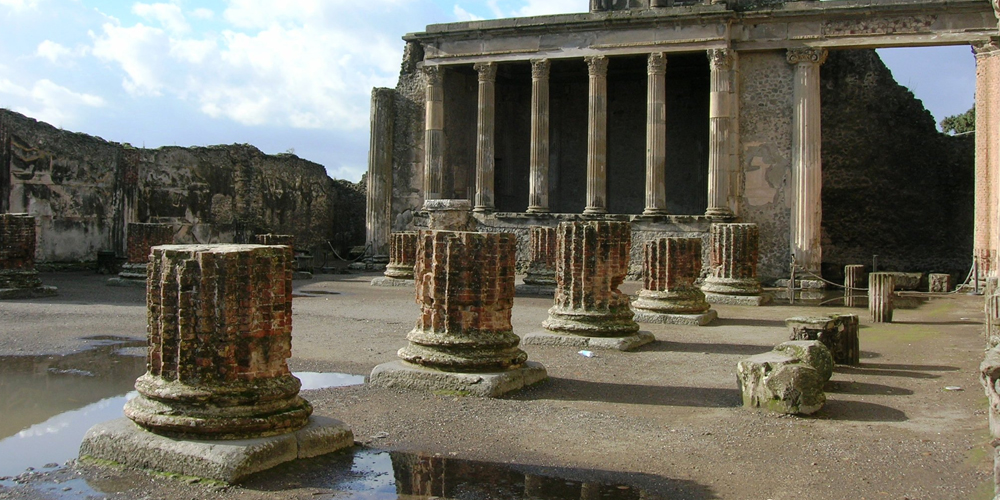The city of Pompeii

A stone's throw from the city of Naples, which was founded by the Greeks and then conquered by the Romans, there was a thriving, lush and persuasive town, which tempted all Romans in search of a place where they could enjoy all the pleasures far from Rome, Pompeii.
Things to see in Pompeii
Pompeii is one of the most magical places where time seems to have stopped two thousand years ago. At the gates of Salerno and not far from Naples, this place contains wonders and answers on the life of over two thousand years ago when the Romans populated these areas.
There are unparalleled testimonies in any other part of the world and others still buried under the earth, Pompeii is unique. It comes with several entrances located in correspondence of the main streets that mark the checkerboard rhythm of every Roman city of the time and that lead you to discover beautiful places.
The history of the Pompeian amphitheater
The Pompeian amphitheatre is the oldest stone construction of its kind. It dates back to just over 150 years before the eruption that destroyed Pompeii. With a length of 135 meters and a width of just over 100 meters, it could accommodate about 20.000 people, who could attend at any time of the year thanks to the imposing cover that protected from the sun and bad weather.
The amphitheatre was built around 70 BC. by the duoviri Gaio Quinzio Valgo and Marco Porcio and it was built outside the city centre so as not to hinder public life and also to use, for structural designs, the disused walls.
It is one of the best-preserved buildings of its kind, with a depth of 6 meters hosted circus shows and gladiator fights, but it was also a show of different historical facts such as a quarrel between Pompeians and Nocera for the control of some territories previously belonging to Pompeii and subsequently entrusted to Nocera after having also become a Roman colony, a dispute so inflamed as to be remembered even by the Roman historian Tacitus, which led to the closure of the amphitheatre for 10 years.
Nowadays the amphitheatre has been brought into vogue by Pink Floyd with their 1971 Live at Pompei and by the exhibition of Francesco Venezia.
The house of the Faun: Roman art in Pompeii
The house of the Faun, named after the discovery of a small statue of a dancing satyr placed in its impluvium, is one of the largest and oldest buildings in Pompeii. Belonging to a wealthy magistrate of the time, it was built 200 years before the eruption that destroyed Pompeii.
The house is large three thousand square meters and hosts a variety of venues ranging from private spaces to public ones passing through lobbies and religious spaces. Long its walls have been found frescoes and mosaics depicting tragic masks or war scenes, such as the floor mosaic of the Battle of Isso between Alexander the Great and Darius king of Persia, probably made to indicate a link between the Macedonian king and the owner of the imposing home.
Inside the house, which can be divided into two large areas, there are many places, some of which were probably rented to merchants to make it unique, while accessing from the vestibule to the south, we arrived at the aforementioned impluvium, then continuing northwards there are two subsequent peristyles added to the house which were to celebrate the magnificence of its owner.
The mistery house
Smaller than the house of the Faun, the villa of the Mysteries takes its name from the frescoes found inside that have an almost mystery value. Nobody knows their meaning. The house had its heyday in the Augustan age even though it was built about a century earlier. Located outside the city to the north, in a panoramic area overlooking the sea, after the villa fell into disrepair it was transformed into a rustic villa used for the processing of oil and wine.
As for the frescoes inside, as mentioned above, nobody knows the meaning and assumes different theories. The frescoes depict a girl's preparation for some kind of ritual: some think of a bacchanal and others who simply think of a wedding ceremony.
The fugitive garden: the eruption of Vesuvius in Pompeii
The beauty of Palazzo Della Mura in Angri
Pompeii offers an overview of attractions that you will hardly find anywhere else in the world, there are dozens of more places to tell and visit, which cannot all be enclosed here. From the temples of Jupiter and Apollo to the forum and the house of Sallustio are all the events of note and visit, almost for more than a few days. Pompeii is present at the gates of Salerno and other suggestive places such as Nocera and Angri. If you decide to stay in Pompeii I can not do without one of the best places to stay in the area, that is, Palazzo Della Mura in Angri, a stone's throw from Pompeii. An enchanting and hospitable place close to priceless beauties such as the Amalfi Coast.










Lascia un commento